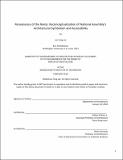| dc.contributor.advisor | William O'Brien Jr. | en_US |
| dc.contributor.author | Lee, Jae Yong, M. Arch Massachusetts Institute of Technology | en_US |
| dc.contributor.other | Massachusetts Institute of Technology. Department of Architecture. | en_US |
| dc.coverage.spatial | a-ko--- | en_US |
| dc.date.accessioned | 2018-05-23T15:04:50Z | |
| dc.date.available | 2018-05-23T15:04:50Z | |
| dc.date.copyright | 2018 | en_US |
| dc.date.issued | 2018 | en_US |
| dc.identifier.uri | http://hdl.handle.net/1721.1/115615 | |
| dc.description | Thesis: M. Arch., Massachusetts Institute of Technology, Department of Architecture, 2018. | en_US |
| dc.description | This electronic version was submitted by the student author. The certified thesis is available in the Institute Archives and Special Collections. | en_US |
| dc.description | Cataloged from student-submitted PDF version of thesis. | en_US |
| dc.description | Includes bibliographical references (page 72). | en_US |
| dc.description.abstract | This thesis examines the architectural potential through the functional extension of the plaza and reconstruction of the symbolic National Assembly to answer questions. Creating a space of ramps will heighten perceptions of accessibility of the National Assembly. The plaza becomes the place of communication as it establishes a new relationship between the space of the ramp and the National Assembly. Today, the perception of the National Assembly in Seoul, Korea is as an authoritarian and inaccessible space. The large plaza in front of the building is only accessible if one passes the security check; as a result, normal citizens rarely use the area. Because the building is only 30 years old, rebuilding an entire new structure is neither feasible nor plausible. Considering this situation and the history, what kind of architectural transformation could be made to change people's perception towards the National Assembly Building and its surrounding area? What architectural language or device could be used to enhance the accessibility and symbolism of the space? The space of the ramp symbolizes equal accessibility and facilitates a political dialogue between citizens and the government. Instead of being a mere vertical circulation device from floor to floor, the ramp is designed in diverse ways to acquire a more meaningful status, both functionally and symbolically. Unlike the columns which were used merely as ornamentation in the National Assembly, columns in the new architecture structurally support the ramp as well as symbolically support people coming to this new space to see the National Assembly from different perspectives. The monumentality of the authoritative architecture becomes diluted through a transparent and approachable public space that generates a new image of Korea's political architecture. This architectural intervention hopefully results in changing the perception towards the National Assembly from an authoritarian and inaccessible space to an open and accessible space. | en_US |
| dc.description.statementofresponsibility | by Jae Yong Lee. | en_US |
| dc.format.extent | 72 pages | en_US |
| dc.language.iso | eng | en_US |
| dc.publisher | Massachusetts Institute of Technology | en_US |
| dc.rights | MIT theses are protected by copyright. They may be viewed, downloaded, or printed from this source but further reproduction or distribution in any format is prohibited without written permission. | en_US |
| dc.rights.uri | http://dspace.mit.edu/handle/1721.1/7582 | en_US |
| dc.subject | Architecture. | en_US |
| dc.title | Renaissance of the ramp : reconceptualization of National Assembly's architectural symbolism and accessibility | en_US |
| dc.type | Thesis | en_US |
| dc.description.degree | M. Arch. | en_US |
| dc.contributor.department | Massachusetts Institute of Technology. Department of Architecture | |
| dc.identifier.oclc | 1036986866 | en_US |
